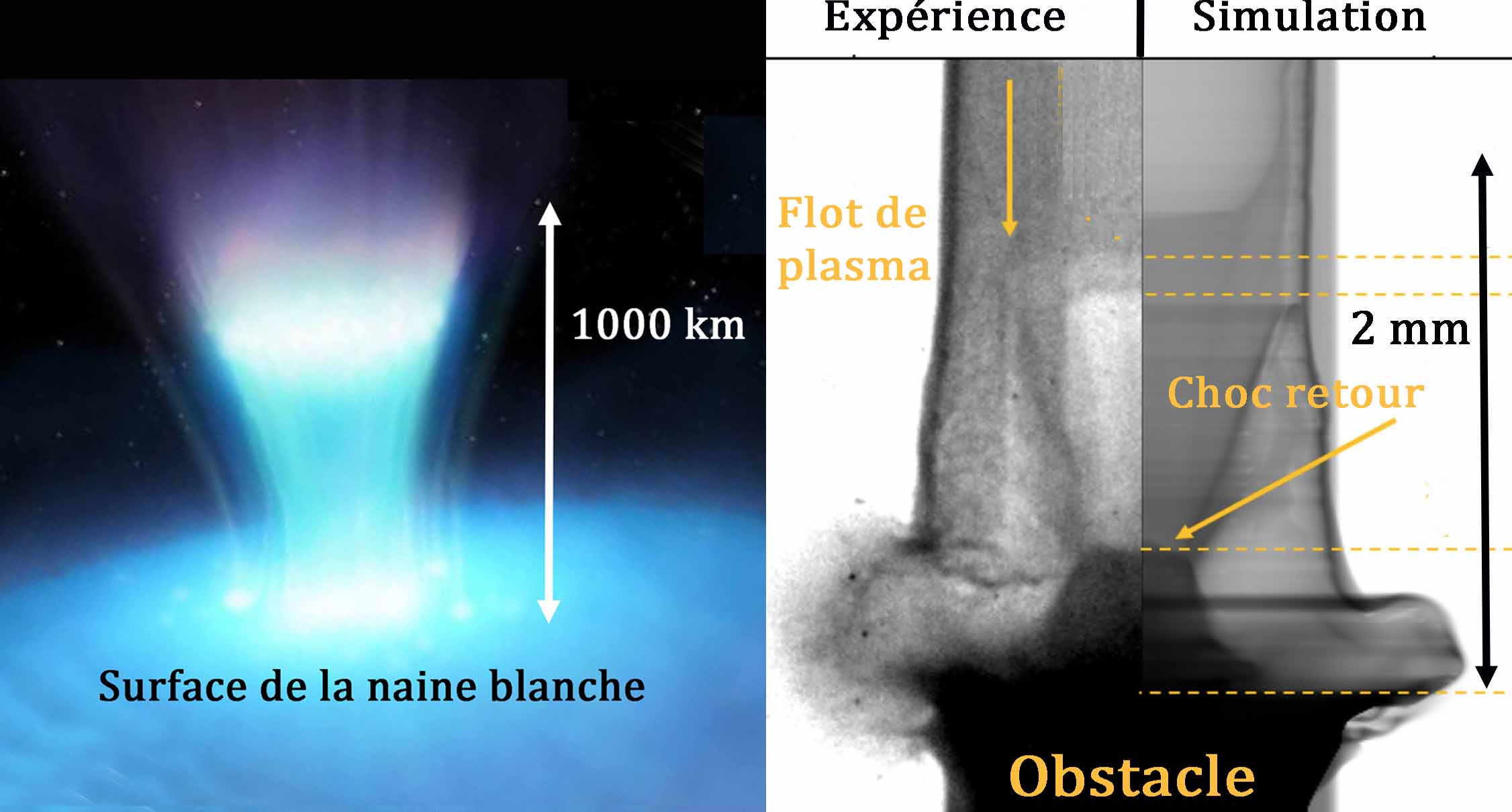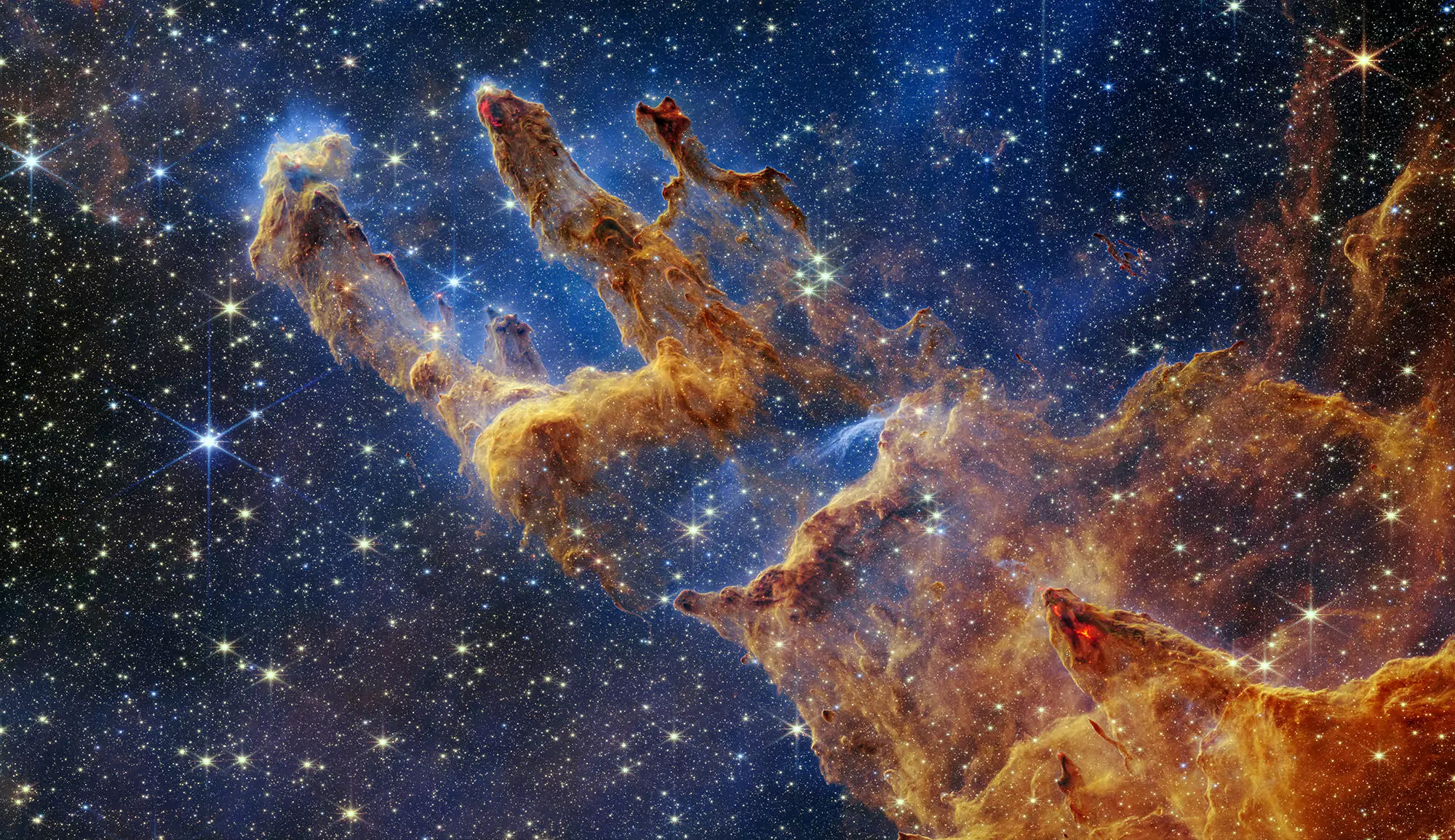
In such systems, a «white dwarf», an extremely dense star, "sucks" via gravity matter from a second neigbouring star, leading to the emission of very energetic radiation when the matter reaches the surface of the dense star. In order to recreate these phenomena in the laboratory, scientists used the powerful laser Orion which isin the United Kingdom: this enabled them to vaporize a millimeter thick target in a very short interval of time (one one hundred-thousandth of a second) and so create the phenomena eqkuivalent to those which take place on the poles of a white dwarf.
White dwarfs, very dense stars which often have a high magnetic field, can sometimes absorb matter from acompanion star. This matter is concentrated and sucked up by the white dwarf at at its magnetic ples, resulting in a 100 to 1000 km long accretion column. These regions are too smalll to be observable directly in a telescope. In order to study tte physical phenomena which take place in the negibourhood of a magnetic pole, scientists decided to recrete them in the labratory.
To do this, they concentrated, for a hundred thousandth of a second, all the energy of the Orion laser onto several millimetre square surface. They were thus able to generate a plasma flow moving at a speed of 200 km/s which, striking a thin steel target, recreated the phenomena which take place on the sarface of a white dwarf. With the help of a second laser beam, they were able to probe, via X rays, the dynamics of the accretion column. This experiment, the first of its kind in the world, constitutes a laboratory model of an astrophysical object.
It is important that astrophysicists and cosmologists understand better white dwarfs and their dynamics. They could in fact be the precursors of supernovae (stellar explosions), celestial objects which are used to determine the expansion of the Universe. In the near future, such experiments could use the far more powerful LMJ laser.

About power lasers
Orion is a laser in the United Kingdom, under the aegis of theAtomic Weapons Establishment (AWE). It combines 10 "long" pulsed beams (nanosecond, 10-9 s, time scale) and two ultra-short beams (less than a picosecond 10-12 s). Such experiments, begun several years ago at Luli2000 (Laboratoire pour l’utilisation des lasers intenses) at the École Polytechnique, could inthe near future profit from the LMJ lasers and Petal, which are far more powerful. The LMJ-Petal installation (in the Gironde) is under the aegis of the CEA and combines the 176 fbeams of the Laser Mégajoule with the petawatt Petal beam.
The laboratories involved are:
- Astrophysique, Interprétation, Modélisation (AIM, CEA/Université Paris Diderot/CNRS) ;
- Laboratoire pour l’utilisation des lasers intenses (LULI, CNRS/École polytechnique/UPMC/CEA) ;
- Laboratoire Univers et Théories (LUTH, CNRS/Université Paris Diderot/Observatoire de Paris) ;
- La direction des applications militaires du CEA, DAM-DIF.
References
Cross, J. E. et al., Laboratory analogue of a supersonic accretion column in a binary star system. Nat.
Commun. 7:11899 doi: 10.1038/ncomms11899 (2016)
À propos des lasers de puissance
Orion est un laser basé au Royaume-Uni, sous le pilotage de l’Atomic Weapons Establishment (AWE). Il combine 10 faisceaux à pulsation « longue » (échelle de la nanoseconde, 10-9 s) et deux faisceaux ultra-brefs (inférieurs à la picosecondes, 10-12 s). De telles expériences, initiées il y a quelques années sur l’installation Luli2000 (Laboratoire pour l’utilisation des lasers intenses) à l’École Polytechnique, pourront dans un futur proche bénéficier des lasers LMJ et Petal, beaucoup plus puissants. L’installation LMJ-Petal (en Gironde) est pilotée par le CEA et combinera les 176 faisceaux du Laser Mégajoule au faisceau petawatt Petal.
Les laboratoires impliqués sont :
- Astrophysique, Interprétation, Modélisation (AIM, CEA/Université Paris Diderot/CNRS) ;
- Laboratoire pour l’utilisation des lasers intenses (LULI, CNRS/École polytechnique/UPMC/CEA) ;
- Laboratoire Univers et Théories (LUTH, CNRS/Université Paris Diderot/Observatoire de Paris) ;
- La direction des applications militaires du CEA, DAM-DIF.
Références
Cross, J. E. et al., Laboratory analogue of a supersonic accretion column in a binary star system. Nat.
Commun. 7:11899 doi: 10.1038/ncomms11899 (2016)
